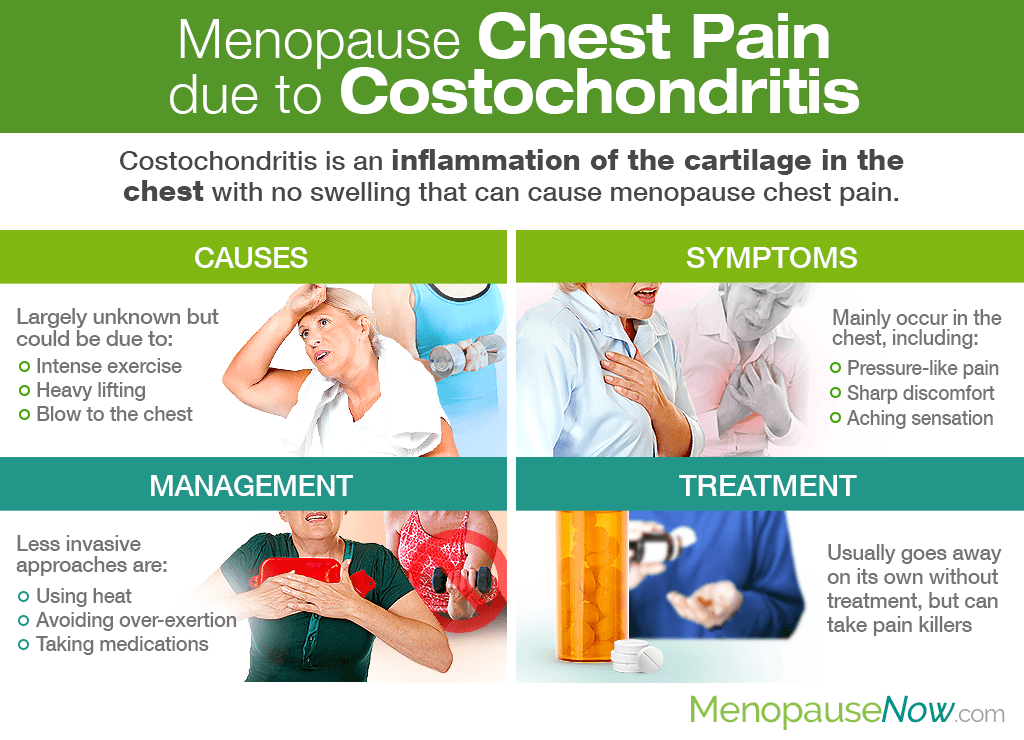Chest pain during menopause is no stranger to many women as they transition out of their fertile years. However, when they are told their pain is due to costochondritis, a little-known, inflammatory condition, they may exhaust resources in trying to find out exactly how it occurred and how to go about treating it.
Continue reading to learn all about menopause chest pain due to costochondritis, including costochondritis meaning, causes, symptoms, management, and more.
Define Costochondritis
Also recognized as costosternal syndrome or anterior chest wall syndrome, costochondritis is inflammation of cartilage in the chest, specifically where the ribs join the breastbone, without the presence of swelling.
Costochondritis Causes

Usually, the cause of costochondritis remains largely unknown, yet luckily, costochondritis is not due to heart or lung problems.
While costochondritis is more common in women who are over the age of 40, this condition does not have a scientifically researched correlation with hormones.
This inflammation of rib cartilage can be due to intense exercise, lifting heavy objects, a blow to the chest, or an illness that causes excessive amounts of coughing and sneezing, such as respiratory tract or post-operation infections. It also commonly occurs during times of emotional stress.
Costochondritis Symptoms

While costochondritis is painful, it is not dangerous and normally causes symptoms mainly concentrated in the chest, such as:
- Tenderness
- Pressure-like pain
- Sharp discomfort
- Aching sensation
- Painful to the touch
- Pain worsened with upper body movement and deep breathing
It is important to note that costochondritis usually disappears on its own within the first week or two, although it may occur again. It is uncommon that a more serious condition causes symptoms similar to those of costochondritis.
Also, costochondritis can be the underlying cause of noncyclical breast pain during menopause as the discomfort can radiate into the breast.
Fortunately, women can manage symptoms of costochondritis for an improved quality of life.
Costochondritis Management

Because costochondritis is benign, non-invasive approaches are generally effective for managing the condition. They are:
Use heat. Consider applying a wet, hot compress or heating pad to the area to ease pain.
Apply cream. Using a medicated skin cream from your healthcare provider may also help relieve costochondritis pain.
Avoid over-exertion. Women suffering from costochondritis pain should avoid lifting heavy objects, intense exercise, or partaking in any activity that aggravates symptoms.
Stretch. Your doctor may provide you with stretching exercises to ease the discomfort, which may include neck rotation exercises.
Take medications. Taking a short course of analgesics for the pain or nonsteroidal anti-inflammatory drugs (NSAIDs) for the inflammation may also be recommended.
Relieve stress. For women whose costochondritis is due to emotional stress, partaking in yoga, meditation, deep breathing exercises, a favorite hobby, or other methods of relaxation would help calm the condition.
Costochondritis Treatment

Since it is generally a self-limiting, benign condition that goes away on its own, costochondritis treatment begins with instilling the various, aforementioned management techniques.
If after using these approaches women still do not find relief, an injection of a local anesthetic or corticosteroid may be recommended for the pain.
In all cases, meet and follow-up with an experienced medical doctor who can guide you through all stages on your path to recovery.
Conclusions
While menopausal chest pain due to costochondritis can leave women out of their daily routines for a couple days or weeks, it is important to keep in mind that the condition is not life-threatening, and the outlook is bright. Nevertheless, if women feel as if their recovery is slow, they should speak with their doctors in order to create a personalized treatment plan, which could also include menopause symptoms treatments for long-lasting relief. Your well-being starts and ends with you.
Sources
- Creaky Joints. (2019). What Is Costochondritis? The Alarming Arthritis Chest Pain You Might Not Know About. Retrieved August 27, 2019, from https://creakyjoints.org/comorbid-conditions/what-is-costochondritis/
- Fairview. (n.d.). Chest Wall Pain: Costochondritis. Retrieved August 27, 2019, from https://www.fairview.org/patient-education/115934EN
- Harvard Health Publishing. (2018). Breast pain: Not just a premenopausal complaint. Retrieved August 27, 2019, from https://www.health.harvard.edu/pain/breast-pain-not-just-a-premenopausal-complaint
- Winzenberg, T. et al. (2015). Musculoskeletal chest wall pain. Australian Family Physician, 44(8), 540-544. Retrieved August 27, 2019, from https://www.racgp.org.au/afp/2015/august/musculoskeletal-chest-wall-pain/

